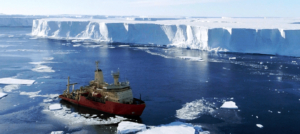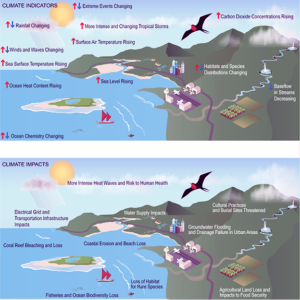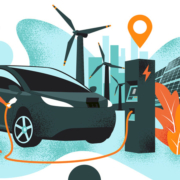Hawaii-based climate solutions needed now
Update: Jan. 11th, 2022
Hawaii Legislature Update on Climate Issues
According to House Finance Committee Chair Sylvia Luke, “now that we have more revenues coming in, we need to make commitments. We need to make money commitments in order for us to address climate change.”
The Environmental Legislative Caucus, a group formed in 2020 to encourage legislative action on environmental issues, plans to introduce a package of measures including visitor green fees, habitat conservation, carbon pricing, health initiatives and more.
Similarly, the Hawaii Climate Change Mitigation and Adaptation Commission, a legislative advisory group composed of state and county officials, plans to prioritize ground transportation reduction and adaptation to sea level rise.
Originally Published: Jan. 7th, 2022
Hawaii’s Political Inertia
Hawaii’s District 8 Representative and Chair of the House Energy and Environmental Committee, Nicole Lowen, recently wrote in Civil Beat… “We do not need to look far to see how the climate crisis is shaping life in Hawaii. Climate change is fueling extreme weather across our state, including wildfires and floods.”
Rep. Lowen gets it, which is more than can be said for many of her colleagues in Hawaii’s House and Senate.
There is no way around it, the state, the country, and the world must undertake with all vigor meaningful action to more than just cut fossil fuel emissions, and as a community of islands engage in a true transformation into a sustainable and self-sufficient lifestyle.
For Hawaii, this means greater emphasis on accountability in grand legislative goals with far reaching deadlines, e.g., the state’s Renewable Portfolio Standard (RPS) for conversion to a statewide clean and renewable energy transformation by 2045 – a policy which trades present day fossil fuel dependencies for renewable energy replacements.
This far reaching and insightful statewide energy strategy was born in the 1990’s and has been designed to advance and enable zero emissions clean energy sources, e.g., solar and wind (Hawaii’s natural energy assets). At the same time, the same renewable energy policy allows in costly and polluting fossil fuel energy substitutes, some which directly contribute to, rather than mitigate, climate change impacts. One current example of this mix and match energy policy is Honua Ola (aka Hu Honua) — a costly (in terms of energy replacement costs to the environment and climate), and takes the form a cutting and burning trees-for-energy replacement strategy in partnership with the HECO.
Thwaites; Glacier Meltdown
What’s the hurry you ask, we’ve got time to work out all this climate stuff — well, not really. The climate clock is ticking down to zero hour faster than many people recognize or choose to admit. Never before has the saying …think globally, act locally, applied so well to Hawaii’s future.
Hawaii’s geographic isolation is not a Climate Change solution, nor is this a problem confined to the mainland or far off countries and cultures. Weather, climate, social and economic climate changes are global. Certainly, swaying palm trees, sunrises and sunsets which may momentarily take your breath away are small comfort or relief from a human-induced and runaway climate change experiment now impacting the entire planet.
One example of faraway global changes with local consequences was news of the little known Thwaites Glacier, a West Antarctic Ice Sheet glacier which scientists describe as the cork in the bottle which is holding back rapid sea level rise.
 The Thwaites Glacier is size of Britain, and is retreating rapidly as a warming ocean erases its ice from below, leading to faster flow, more fracturing and collapse, according to an international team of scientists. This one glacier currently contributes to over four percent of annual global sea level rise.
The Thwaites Glacier is size of Britain, and is retreating rapidly as a warming ocean erases its ice from below, leading to faster flow, more fracturing and collapse, according to an international team of scientists. This one glacier currently contributes to over four percent of annual global sea level rise.
“Thwaites is the widest glacier in the world,” according to Ted Scambos, a senior research scientist at the Cooperative Institute for Research in Environmental Sciences (CIRES). “It doubled its ice-to-water outflow speed within the last 30 years, and the glacier in its entirety holds enough water to raise sea level by over two feet. This will lead to even more sea-level rise, up to 10 feet, if it draws the surrounding glaciers with it. If Thwaites were to collapse, it would drag most of West Antarctica’s ice with it,” said Scambos.
Scientists, recently speaking at the American Geophysical Union sponsored event, reported that the keystone Antarctic glacier will likely collapse in the next five to ten years. This is by far the most aggressive science-driven projection of a predicted collapse. Fractures that span more than 40 kilometers across nearly the entire Thwaites Glacier and ice shelf are showing signs of an impending collapse. What does have to do with Hawaii.., plenty.
If Thwaites Glacier, and other critical neighboring glaciers such as Pine Island Glacier, cannot hold back the West Antarctic Ice Sheet, which holds the equivalent of 3.3 meters (10.8 feet) in sea level, it will affect coastlines across the world, and most certainly islands throughout the Pacific, including the Hawaii.
The submerged mountain of ice, the size of Florida, presently serves as a sea barrier for the massive Antarctic ice flow — in effect, Thwaites is the a cork in a bottle for the West Antarctic Ice Sheet.
Thwaites Glacier (the melting tongue, aka cork in the bottle)

What does this mean for Hawaii?
To start… the corresponding sea level rise from a Thwaites Glacier meltdown will likely result in a new norm for Hawaii’s famous beaches, coastline properties and commercial assets, including ports and airports, projected impacts previously acknowledged by internal state studies.
Rising sea levels will also bring with them not only flooding, but saltwater invasion of fresh water supplies across the island chain.
Fisheries and coral reefs are already facing human-induced climate stressors. The livelihoods they support are also threatened by escalating ocean temperatures and ocean acidification, with sea level rise just one more disruptive component tied to ever growing state of global climate heating. It’s no wonder that economic and social consequences of climatic change now underway will not exempt Hawaii from these transformational changes.

The U.S. Pacific Islands are culturally and environmentally diverse, and treasured by the 1.4 million people who call Hawaii home.
As a region, the Pacific islands are particularly vulnerable to climate change impacts due to their exposure and isolation, small size, low elevation (in the case of atolls), and concentration of infrastructure and economy along the coasts.
In multiple assessments lead by Department of Commerce / National Oceanic and Atmospheric Administration in a “Nati0nal Climate Assessment” various participating federal government agencies agree on several common conclusions as to global heating impacts specific to Hawaii and other Pacific island communities:
- “Sea level rise will disproportionately affect the tropical Pacific, potentially exceeding projected global sea level rise estimates”.
The impacts of sea level rise in the Pacific include coastal erosion, episodic flooding, permanent inundation, heightened exposure to marine hazards, and saltwater intrusion to surface water and groundwater systems.
The Federal strategy towards addressing climate changes for the Pacific region has been summed up this way:
“Across the region, groups are coming together to minimize damage and disruption from coastal flooding and inundation as well as other climate-related impacts. Social cohesion is already strong in many communities, making it possible to work together to take action. Early intervention can lower economic, environmental, social, and cultural costs and reduce or prevent conflict and displacement from ancestral land and resources.”
What Can Hawaii Do?
We can start by addressing with our own contributions to the problem…
We can develop local and proactive solutions that include, but are not limited; corrective measures which support environmental-climate friendly economic opportunities based on sustainable economics and business practices.
As this new year gets underway a coalition statewide groups have joined together to contribute their ideas and expertise to the challenges facing Hawaii. The coalition’s mission is to provide representative solutions to the public and politicians as Hawaii Environmental Change Agents (HECA). The coalition’s priorities for 2022 and beyond has been summed up this way:
“The extreme weather caused by climate change is becoming more severe and more pervasive throughout the world,” according to Charley Ice, a member of the event planning committee…” “Climate change is such a large and complex issue that a multi-faceted approach is needed. We will explore Hawaii’s most effective, practical alternatives…”
A diverse set of citizen groups comprise Hawaii Environmental Change Agents, their agenda focus for Hawaii’s 2022 legislative session reflects the diversity of the working group and includes, but is not limited to;
- Carbon Pricing
- Visitor Impact Fee (Green Fee)
- Green Constitutional Amendment
- Decarbonization of Transportation
- Decarbonization of Buildings
- Carbon Sequestration
- Renewable Clean Energy Reforms
- Wastewater and Cesspool Reforms
- Hawaii Reef, Reef fish, and Ocean Protections
- Climate Justice
There are an estimated 300 environmental organizations currently active in Hawaii.




Wow! 300 or so environmental organizations today…
And to think back fifty years ago, when apparently a one man shop (Henry Curtis) with his “Life of the Land” multi-disciplinary public service entity carried, and still carries, the ball with force and assuredness. He just does it all! Amazing!
(Plus, I’m being thankful in advance as he carries on the battle for real clean energy, intervening with PUC against the big dog Hu Honua show here on Hawaii Island!)